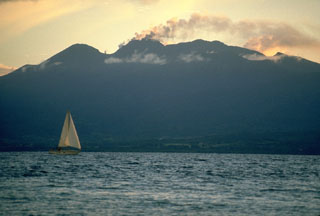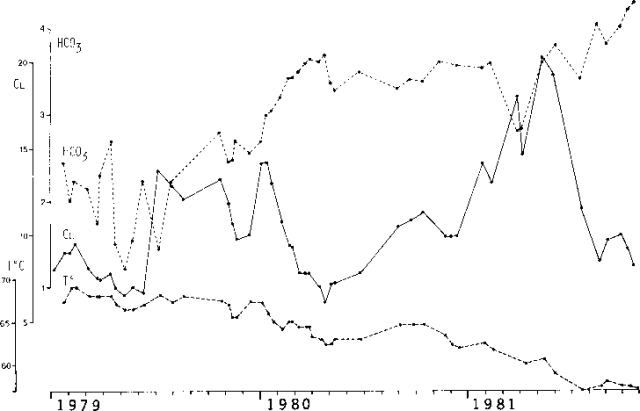Report on Soufriere Guadeloupe (France) — January 1982
Scientific Event Alert Network Bulletin, vol. 7, no. 1 (January 1982)
Managing Editor: Lindsay McClelland.
Soufriere Guadeloupe (France) Temperatures and chemistry of thermal springs
Please cite this report as:
Global Volcanism Program, 1982. Report on Soufriere Guadeloupe (France) (McClelland, L., ed.). Scientific Event Alert Network Bulletin, 7:1. Smithsonian Institution. https://doi.org/10.5479/si.GVP.SEAN198201-360060
Soufriere Guadeloupe
France
16.044°N, 61.664°W; summit elev. 1467 m
All times are local (unless otherwise noted)
Since January 1979, samples have been collected 2-3 times per month from six springs with water temperatures of 25-69°C, 0.5-3.5 km from the summit dome. Water temperatures and chemistry remained nearly constant at five of the six springs, as shown by the following maximum variations recorded at any one spring in the nearly 3 years of sampling: temperature (°C) 4%, pH 5%, Cl 20%, HCO3 25%, F 25%. These variations were independent of rainfall and apparently random.
However, Carbet l'Echelle spring, the hottest and nearest to the summit (0.5 km) showed appreciable changes during the survey period. Its water temperature dropped from 69°C in January 1979 to 57° in November 1981, while the concentration of HCO3 ions approximately doubled and large variations in Cl concentrations occurred (figure 9).
Geological Summary. La Soufrière de la Guadeloupe volcano occupies the southern end of Basse-Terre, the western half of the island of Guadeloupe. Construction of the Grand Découverte volcano about 200,000 years ago was followed a Plinian eruption and caldera formation about 100,000 years later, and then by construction of the Carmichaël volcano within the caldera. Two episodes of edifice collapse and associated large debris avalanches formed the Carmichaël and Amic craters about 11,500 and 3,100 years ago, respectively. The present volcano subsequently grew within the Amic crater. The summit consists of a flat-topped lava dome, and several other domes occur on the southern flanks. Six phreatic explosive eruptions since 1690 opened radial fractures across the summit lava dome. The phreatic eruptions in 1976-77 caused severe economic disruption when Basse-Terre, the island's capital city immediately below the volcano, was evacuated.
Information Contacts: S. Bigot, Lab. de Géochemie, Paris; G. Hammouya, Lab. de Physique du Globe; J. Le Mouel and J. Cheminée, IPG, Paris.


